
- •Digital data acquisition and networks
- •Digital representation of numerical data
- •Integer number formats
- •Example of industrial number formats
- •Digital representation of text
- •Morse and Baudot codes
- •EBCDIC and ASCII
- •Unicode
- •Analog-digital conversion
- •Converter resolution
- •Converter sampling rate and aliasing
- •Analog signal conditioning and referencing
- •Analog input references and connections
- •Digital data communication theory
- •Serial communication principles
- •Physical encoding of bits
- •Communication speed
- •Data frames
- •Channel arbitration
- •The OSI Reference Model
- •EIA/TIA-232, 422, and 485 networks
- •Ethernet networks
- •Repeaters (hubs)
- •Ethernet cabling
- •Switching hubs
- •Internet Protocol (IP)
- •IP addresses
- •Subnetworks and subnet masks
- •Routing tables
- •IP version 6
- •Transmission Control Protocol (TCP) and User Datagram Protocol (UDP)
- •The HART digital/analog hybrid standard
- •Basic concept of HART
- •HART physical layer
- •HART multidrop mode
- •Modbus
- •Modbus overview
- •Modbus data frames
- •Modbus function codes and addresses
- •Modbus relative addressing
- •Modbus function command formats
- •Review of fundamental principles
- •FOUNDATION Fieldbus instrumentation
- •FF design philosophy
- •H1 FF Physical layer
- •Segment topology
- •Coupling devices
- •Electrical parameters
- •Cable types
- •Segment design
- •H1 FF Data Link layer
- •Device addressing
- •Communication management
- •Device capability
- •FF function blocks
- •Analog function blocks versus digital function blocks
- •Function block location
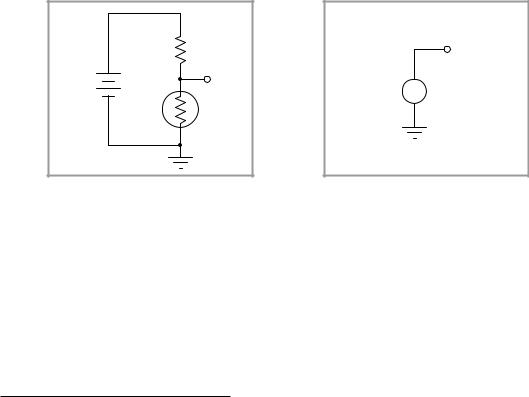
15.4. ANALOG SIGNAL CONDITIONING AND REFERENCING |
1011 |
15.4.2Analog input references and connections
Most analog signals in industry come in the form of voltages. Even the ubiquitous 4 to 20 milliamp DC analog signal standard is typically converted into a 1 to 5 volt DC voltage signal before entering an electronic recorder, indicator, or controller. Therefore, the most common form of data acquisition device for analog measurement is one that accepts a DC voltage input signal. However, voltage signals cannot all be treated the same, especially with regard to a very important concept called ground reference. This portion of the book is devoted to an exploration of that concept, and how we may measure di erent kinds of voltage signals with real data acquisition devices.
First, let’s examine some examples of analog voltage signal sources. For consistency, we will focus on di erent circuits that all sense temperature and output proportional DC voltages. Our first example is a simple voltage-divider circuit using an RTD (Resistance Temperature Detector) as the primary sensing element. An RTD is a variable resistance with a positive temperature coe cient: increasing resistance as temperature increases. Connected as shown, it will generate a signal voltage roughly18 proportional to sensed temperature:
Ground-referenced voltage signal
Real circuit |
Voltage-source model |
Rfixed |
Vsignal |
Vsignal |
+ |
Vexcite |
|
RTD |
Vsignal − |
|
The power source for this circuit is commonly referred to as an “excitation” source, hence the
label Vexcite. The voltage signal measurable across the RTD is what we might refer to as a groundreferenced voltage signal, because one pole of it is directly connected (common) to ground.
18The relationship of temperature to Vsignal in this sensor circuit will not be precisely linear, especially if Rf ixed is not tremendously larger than RRT D .
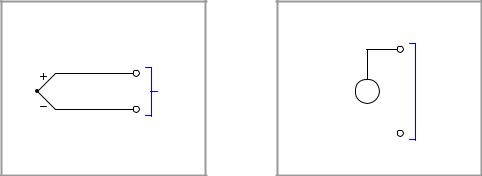
1012 |
CHAPTER 15. DIGITAL DATA ACQUISITION AND NETWORKS |
Our next example is a device called a thermocouple – a pair of dissimilar-metal wires joined together to form a junction. Thermocouple junctions produce small amounts of voltage directly proportional to temperature. As such, they are self-powered devices, needing no “excitation” power sources to operate:
Floating voltage signal
Real circuit |
Voltage-source model |
Thermocouple
|
+ |
|
|
|
|
Vsignal |
Vsignal − |
|
|
Vsignal |
|
|
|
||||
|
|
|
|
|
|
If the thermocouple junction is insulated from earth ground, we refer to it as a floating voltage signal. The word “floating” in this context refers to a complete lack of electrical connection to earth ground.
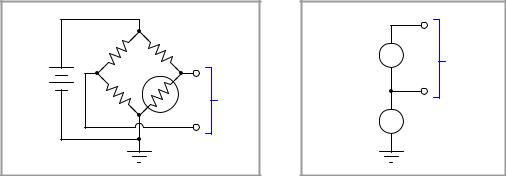
15.4. ANALOG SIGNAL CONDITIONING AND REFERENCING |
1013 |
Returning to the use of RTDs for measuring temperature, another circuit design is the so-called bridge configuration, where an RTD comprises one or more “active” legs of a dual voltage divider. The excitation voltage source connects across two opposite ends of the bridge (powering both voltage dividers), while the signal voltage is measured across the other two opposite ends of the bridge (from one divider mid-point to the other):
Elevated voltage signal (signal + common-mode voltage)
Real circuit |
Voltage-source model |
||
|
Vsignal |
+ |
Vsignal |
|
− |
||
Vexcite |
Vsignal |
|
|
|
+ |
|
|
|
RTD |
|
|
|
Vcommon |
− |
|
The purpose of a bridge circuit is to subtract the “live zero” voltage otherwise dropped by the RTD, which cannot produce a zero-ohm resistance at any temperature. This makes it possible to have a signal voltage range beginning at 0 volts, even though the RTD’s resistance will always be non-zero. The price we pay for this elimination of signal o set is the elevation of the signal from ground potential.
If the fixed-value resistors on the left-hand side of this bridge circuit each have the same resistance, the “common-mode” voltage will be one-half the excitation voltage. This presents an
interesting situation from the perspective of measuring Vsignal, as the common-mode voltage may greatly exceed the signal voltage. We are not particularly interested in measuring the common-mode
voltage because it tells us nothing about the sensed temperature, yet this relatively large voltage is “elevating” our signal voltage from ground potential whether we like it or not, and any data acquisition hardware we connect to the bridge circuit must deal e ectively with this common-mode voltage (i.e. not let it corrupt or otherwise influence the accuracy of the desired signal measurement).
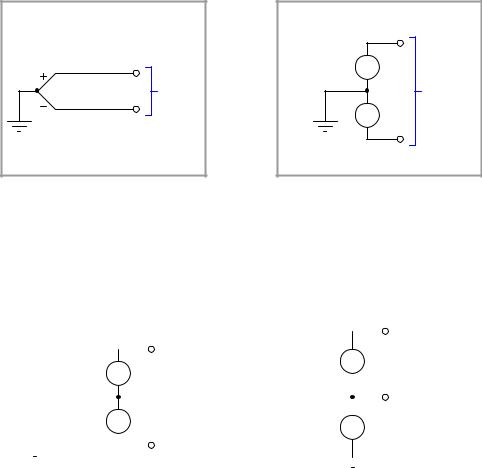
1014 |
CHAPTER 15. DIGITAL DATA ACQUISITION AND NETWORKS |
Yet another type of analog voltage signal is one where the signal is “centered” around ground potential, as is the case with a grounded-tip thermocouple:
Center-grounded voltage signal
Real circuit |
Voltage-source model |
Thermocouple |
+ |
|
− |
Vsignal |
Vsignal |
|
+ |
|
− |
If the centering is perfectly symmetrical, the signal voltage will be evenly “split” about ground potential. The two poles of a 30 millivolt thermocouple signal, for example, will measure +15 mV and −15 mV from ground. This is electrically equivalent to the elevated voltage signal model except with a negative common-mode voltage equal to half the signal voltage:
Center-grounded voltage signal
|
|
|
|
|
|
|
|
|
|
|
|
|
|
|
|
|
|
|
|
|
|
|
|
|
|
|
|
|
|
|
|
|
|
|
|
|
|
|
|
|
|
|
|
|
|
|
|
|
|
|
|
|
|
|
|
|
|
|
|
|
|
|
|
|
|
|
|
|
|
|
|
|
+ |
|
|
|
|
|
|
|
|
||
|
|
|
|
|
|
|
|
|
|
|
|
|
|
|
|
|
|
|
|
|
|
|
|
|
|||
|
|
|
|
|
|
|
|
|
|
|
|
|
|
|
|
|
|
|
|
|
|
|
|
||||
1 |
/2 |
Vsignal |
+ |
|
|
|
|
|
Vsignal |
|
− |
|
|
|
|
|
Vsignal |
||||||||||
|
|
|
|
|
|
|
|
|
|
|
|||||||||||||||||
|
|
|
|
|
|
− |
|
|
|
|
|
|
|
|
|
|
|
|
|
|
|
|
|||||
|
|
|
|
|
|
|
|
|
|
|
|
|
Vsignal |
|
|
|
|
|
|
|
|
|
|
|
|
|
|
|
|
|
1 |
/2 |
Vsignal |
+ |
|
|
|
|
|
|
|
|
|
|
|
|
|
|
|
|
|
||||
|
|
|
|
|
|
|
|
|
|
|
|
|
|
|
|
|
|
|
|
||||||||
|
|
|
|
|
|
|
|
|
|
|
|
|
|
|
|
|
|
|
|
|
|||||||
|
|
|
|
|
|
|
|
V |
|
|
− |
= 1/ |
|
|
V |
|
|||||||||||
|
|
|
|
|
|
− |
|
|
|
|
|
|
|
|
|||||||||||||
|
|
|
|
|
|
|
|
|
|
|
|
|
|
|
|
common |
+ |
|
|
|
2 |
|
|
signal |
|||
|
|
|
|
|
|
|
|
|
|
|
|
|
|
|
|
|
|
|
|
||||||||
|
|
|
|
|
|
|
|
|
|
|
|
|
|
|
|
|
|
|
|
|
|
|
|
||||
|
|
|
|
|
|
|
|
|
|
|
|
|
|
|
|
|
|
|
|
|
|
|
|
|
|
|
|
|
|
|
|
|
|
|
|
|
|
|
|
|
|
|
|
|
|
|
|
|
|
|
|
|
|
|
|
|
|
|
|
|
|
|
|
|
|
|
|
|
|
|
|
|
|
|
|
|
|
|
|
|
|
|
|
|
|
|
|
|
|
|
|
|
|
|
|
|
|
|
|
|
|
|
|
|
|
|
|
|
|
|
|
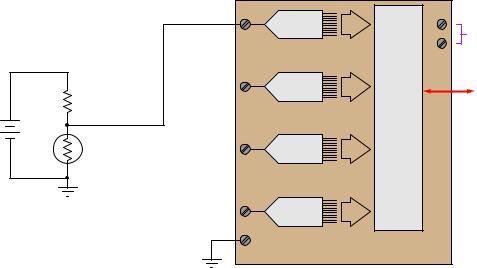
15.4. ANALOG SIGNAL CONDITIONING AND REFERENCING |
1015 |
The type of analog voltage signal posed by our measurement application with becomes relevant when we connect it to a data acquisition device. Floating, ground-referenced, and elevated voltage signal sources each pose their own unique challenges to measurement, and any engineer or technician tasked with accurately measuring these signal types must understand these challenges. Data acquisition devices come in more than one type as well, and must be matched to the type of voltage signal in order to achieve good results.
Let’s begin with our ground-referenced signal source: the simple RTD/resistor voltage divider circuit. If the divider is located close to the data acquisition (DAQ) analog input device, a single wire will su ce for connecting the two:
|
|
Single-ended DAQ inputs |
|
|
IN 1 |
ADC |
|
|
|
Power |
|
|
|
|
|
|
IN 2 |
ADC |
Network |
|
|
||
Rfixed |
|
or |
|
|
|
||
|
|
"bus" |
|
|
|
MUX |
|
Vexcite |
IN 3 |
|
|
RTD |
ADC |
|
|
|
|
||
|
IN 4 |
ADC |
|
|
|
|
|
|
GND |
|
|
Each analog-to-digital converter (ADC) inside the DAQ unit is built to digitize a voltage with reference to ground, which is exactly the type of signal generated by our simple RTD voltage divider circuit. This type of DAQ analog input is called single-ended, and it is generally the default configuration on inexpensive DAQ units.
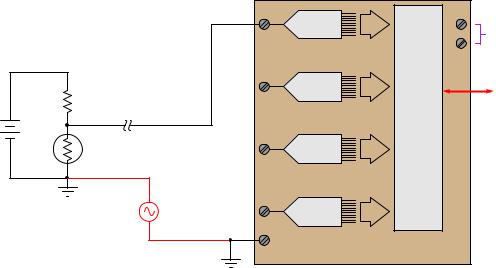
1016 |
CHAPTER 15. DIGITAL DATA ACQUISITION AND NETWORKS |
We cannot simply connect a single-ended DAQ input to a ground-referenced signal source using a single wire, however, if the two are located far apart from each other:
Accurate signal measurement is thwarted |
|
Single-ended DAQ inputs |
|
by the presence of voltage between ground |
|
|
|
|
|
|
|
locations! |
IN 1 |
|
|
|
ADC |
|
|
|
|
Power |
|
|
|
|
|
|
IN 2 |
ADC |
Network |
|
|
||
Rfixed |
|
or |
|
|
|
||
|
|
"bus" |
|
long distance |
|
MUX |
|
|
|
|
|
Vexcite |
IN 3 |
|
|
RTD |
ADC |
|
|
|
|
||
Vnoise |
IN 4 |
ADC |
|
|
|
||
|
GND |
|
|
The problem here is that “all grounds are not created equal” over significant distances. If the ground path is literally through the earth (soil), there will be a myriad of noise sources adding spurious voltage to the measured signal: lightning strikes, ground leakage currents from AC power devices, and other sources of “noise” potential will become a part of the signal loop. Even continuous-metal ground paths over long distances can incur voltage drops significant enough to corrupt precision signal measurements. The grounding conductors used in AC power systems, for example, while continuous (no interruptions) between all points of use in the power system still drop enough millivoltage to significantly compromise instrumentation signals.
In essence, what appears to be a ground-referenced voltage signal source is actually an elevated voltage signal source, with the common-mode voltage being “noise” present between the two di erent ground locations.

15.4. ANALOG SIGNAL CONDITIONING AND REFERENCING |
1017 |
At first, it would seem that connecting the two grounds together with a dedicated length of wire would solve the di erential ground problem. Unfortunately, it does not. The noise sources intercepted through the earth are often of significant power, which just means any conductor stretched between two di erent earth grounds may end up carrying substantial amounts of current, and subsequently dropping voltage along the way due to wire resistance (Vnoise = IgroundRwire).
Adding a bonding wire to make both earth |
|
Single-ended DAQ inputs |
|
ground points common to each other just |
|
|
|
|
|
|
|
produces a ground loop! |
IN 1 |
|
|
|
ADC |
|
|
|
|
Power |
|
|
|
|
|
|
IN 2 |
ADC |
Network |
|
|
||
Rfixed |
|
or |
|
|
|
||
|
|
"bus" |
|
long distance |
|
MUX |
|
|
|
|
|
Vexcite |
IN 3 |
|
|
RTD |
ADC |
|
|
|
|
||
Bonding wire |
|
|
|
Vnoise |
IN 4 |
ADC |
|
|
|
||
Ground loop |
GND |
|
|
This is called a ground loop, and it should be avoided in signal circuits at all cost! Not only may the ground currents still produce significant noise voltage in the measurement circuit, but the ground currents may even become strong enough to damage the bonding wire! Ground loops are often unintentionally formed when the shield conductor of a long signal cable is earth-grounded at both ends.
A reasonable question to ask at this point is, “What constitutes a long distance when connecting ground-referenced signal sources to DAQ modules?” A simple rule to follow is that one cannot rely on ground points to be electrically common to each other (at least not common enough for precise signal-measurement purposes) if those points lie outside the same metal enclosure. If the signal source and DAQ analog input physically dwell inside the same metal enclosure, you can probably rely on the ground points being truly common to each other. If not, you should use some other means of measuring the signal. When in doubt, a sure test is to actually measure the potential di erence between the source and DAQ ground points to see if any exists, being sure to check for AC noise voltage as well as DC.
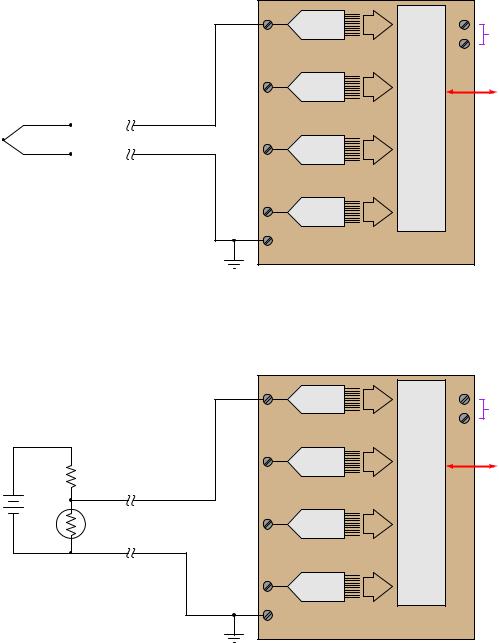
1018 |
CHAPTER 15. DIGITAL DATA ACQUISITION AND NETWORKS |
Here is an example of a single-ended DAQ module successfully measuring a voltage signal source located far away:
Floating signal source
Thermocouple |
long distance |
|||||
|
|
|||||
|
|
|
|
|
|
|
|
|
|
|
|
|
|
Single-ended DAQ inputs
IN 1 |
|
|
ADC |
Power |
|
|
||
IN 2 |
Network |
|
ADC |
||
or |
||
|
"bus" |
|
|
MUX |
|
IN 3 |
|
|
ADC |
|
|
IN 4 |
|
|
ADC |
|
|
GND |
|
Since an ungrounded thermocouple has no connection whatsoever to any ground, there will be no ground loop when connected to a single-ended DAQ input. The same is true for battery-powered sensor circuits lacking connection to earth ground:
|
|
Single-ended DAQ inputs |
|
|
IN 1 |
ADC |
|
|
|
Power |
|
|
|
|
|
Floating signal source |
|
|
|
|
IN 2 |
ADC |
Network |
|
|
||
Rfixed |
|
or |
|
|
|
||
|
|
"bus" |
|
long distance |
|
MUX |
|
|
|
|
|
Vexcite |
IN 3 |
|
|
RTD |
ADC |
|
|
|
|
||
Bonding wire |
|
|
|
No ground connection! |
IN 4 |
|
|
|
ADC |
|
|
|
|
|
|
|
GND |
|
|
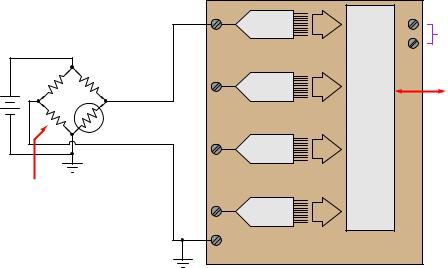
15.4. ANALOG SIGNAL CONDITIONING AND REFERENCING |
1019 |
Single-ended analog DAQ inputs have trouble measuring elevated signal voltages regardless of distance. Here, we see an example where someone has tried to connect a single-ended DAQ input to a grounded-excitation RTD bridge, with common-mode voltage equal to one-half the excitation source voltage. The result is disastrous:
Vexcite
RTD
Common ground connection shorts past the lower-left bridge resistor!
Single-ended DAQ inputs
IN 1 |
|
|
ADC |
Power |
|
|
||
IN 2 |
Network |
|
ADC |
||
or |
||
|
"bus" |
|
|
MUX |
|
IN 3 |
|
|
ADC |
|
|
IN 4 |
|
|
ADC |
|
|
GND |
|
If you follow the bottom wire in this diagram carefully, you will see how it e ectively jumpers past the lower-left resistor in conjunction with the two ground connections. Yet, eliminating the wire simply substitutes one problem for another: without the bottom wire in place, the voltage seen by input channel 1 on the DAQ will be Vsignal + Vcommon−mode rather than Vsignal all by itself.
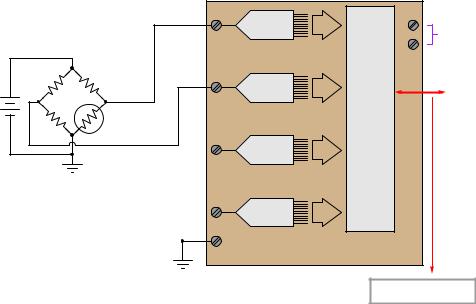
1020 CHAPTER 15. DIGITAL DATA ACQUISITION AND NETWORKS
A clever way to solve the problem of measuring elevated signal sources is to use two analog DAQ
channels: one to measure Vsignal + Vcommon−mode and the other to measure Vcommon−mode, and then digitally subtract one measurement from the other. Thus, two single-ended input channels may
function as one di erential input channel.
Here, we see an example of this measurement technique applied to the grounded-excitation RTD bridge:
|
|
Single-ended DAQ inputs |
|
Vsignal+Vcommon-mode |
IN 1 |
|
|
|
|
ADC |
Power |
|
|
|
|
|
|
IN 2 |
Network |
|
|
ADC |
|
|
|
or |
|
Vexcite |
|
|
"bus" |
|
|
MUX |
|
|
|
|
|
RTD |
Vcommon-mode |
IN 3 |
|
|
|
ADC |
|
|
|
IN 4 |
|
|
|
ADC |
|
|
|
GND |
|
|
|
|
Vsignal = Vin1 - Vin2 |
The subtraction of the two channels’ digitized values may take place in a controller separate from the DAQ module, or within the DAQ module if it is equipped with enough “intelligence” to perform the necessary calculations.
An added benefit of using this dual-channel method is that any noise voltage existing between the signal ground and the DAQ ground will be common to both channels, and thus should cancel when the two channels’ signals are mathematically subtracted.
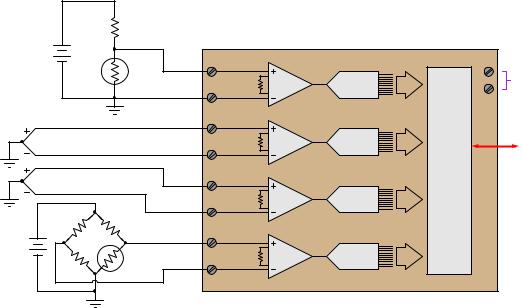
15.4. ANALOG SIGNAL CONDITIONING AND REFERENCING |
1021 |
A more versatile hardware solution for measuring any form of voltage signal is a DAQ equipped with true di erential input channels. Here, each ADC is equipped with its own instrumentation amplifier, measuring the di erence in potential between two ungrounded input terminals:
|
Rfixed |
DAQ module with differential inputs |
|
|
|
|
|
||
Vexcite |
IN 1+ |
|
|
|
|
RTD |
|
|
Power |
|
|
Inst. amp. |
ADC |
|
|
IN 1- |
RG |
|
|
|
|
|
|
|
|
IN 2+ |
|
|
|
|
IN 2- |
Inst. amp. |
ADC |
Network |
|
RG |
or |
||
|
|
|
|
"bus" |
|
IN 3+ |
|
MUX |
|
|
|
|
|
|
|
|
Inst. amp. |
ADC |
|
|
IN 3- |
RG |
|
|
|
|
|
|
|
|
IN 4+ |
|
|
|
Vexcite |
|
Inst. amp. |
ADC |
|
|
IN 4- |
RG |
|
|
|
RTD |
|
|
|
In this example we see one DAQ module measuring four di erent voltage signal sources, with no interference from di erential ground potentials or between the sources themselves. Each input channel of the ADC is electrically independent from the rest. The only limitation to this independence is a certain maximum common-mode voltage between the signal source and the DAQ’s own power supply, determined by the design of the instrumentation amplifiers inside the DAQ module.
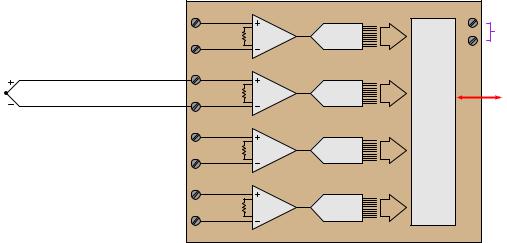
1022 |
CHAPTER 15. DIGITAL DATA ACQUISITION AND NETWORKS |
One important limitation of di erential input channels, however, is that there must be some path for the instrumentation amplifiers’ bias currents to the DAQ’s power supply ground or else the channel will not function properly. This poses a problem where we intend to connect a di erential analog input channel to a floating signal source like this:
|
|
DAQ module with differential inputs |
|
|
|
IN 1+ |
|
|
|
|
|
Inst. amp. |
ADC |
Power |
|
IN 1- |
RG |
|
|
|
|
|
|
|
Floating signal source |
|
|
|
|
(ungrounded thermocouple) |
IN 2+ |
|
|
|
|
|
|
|
|
|
IN 2- |
Inst. amp. |
ADC |
Network |
|
RG |
or |
||
|
|
|
|
"bus" |
|
IN 3+ |
|
MUX |
|
|
|
|
|
|
|
|
Inst. amp. |
ADC |
|
|
IN 3- |
RG |
|
|
|
|
|
|
|
|
IN 4+ |
|
|
|
|
|
Inst. amp. |
ADC |
|
|
IN 4- |
RG |
|
|
|
|
|
|
|
One of the “simplifying assumptions” students learn about operational amplifier circuits is that the input terminals of an opamp draw negligible current. While this may be close enough to the truth when performing calculations on an opamp circuit, it is not absolutely true. All opamps exhibit some amount of bias current at their input terminals, small as these currents may be. Without a complete path to ground for these currents, the input transistor stage of the operational amplifier will not be properly biased, and the amplifier will fail to work as designed.
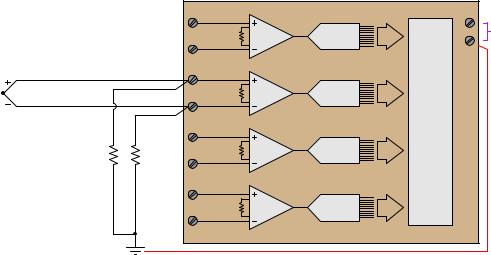
15.4. ANALOG SIGNAL CONDITIONING AND REFERENCING |
1023 |
For this reason, we must connect high-value resistors (typically in the mega-ohm range so as not to load the signal voltage being measured) to each of the di erential input terminals, and then to ground like this:
|
|
|
DAQ module with differential inputs |
|
|
|
IN 1+ |
|
|
|
|
|
IN 1- |
RG |
Inst. amp. |
ADC |
Power |
|
|
|
|||
|
|
|
|
|
|
Floating signal source |
|
|
|
|
|
(ungrounded thermocouple) |
IN 2+ |
|
|
|
|
|
|
|
|
|
|
|
IN 2- |
RG |
Inst. amp. |
ADC |
|
|
|
|
|||
|
|
|
|
|
|
|
IN 3+ |
|
|
MUX |
|
|
|
|
|
|
|
Bias resistors |
IN 3- |
RG |
Inst. amp. |
ADC |
|
(many MΩ) |
|
|
|||
|
|
|
|
||
|
IN 4+ |
|
|
|
|
|
IN 4- |
RG |
Inst. amp. |
ADC |
|
|
|
|
|||
|
|
|
|
|
|
In summary, we may list some essential rules to follow when connecting analog DAQ inputs to voltage signal sources:
•Ground points in di erent locations may not actually be common (enough) to each other
•Never create ground loops through wiring (any conductor connected to ground at each end)
•Beware of common-mode (elevated) signal voltages
•Always ensure a path to power supply ground for amplifier bias currents
